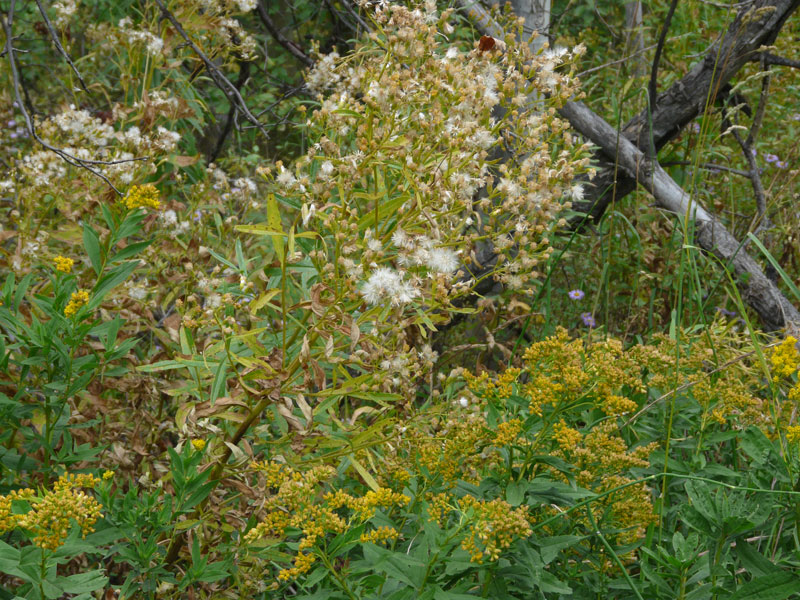Solidago canadensis / goldenrod
- large sprays of yellow flowers in late summer and fall
- often tall and in large colonies
- lance-shaped, toothed leaves
- mostly (but not always) in disturbed areas
Also known as: Canada goldenrod, Canadian goldenrod, meadow goldenrod, common goldenrod, giant goldenrod, tall goldenrod
Goldenrod is an herbaceous perennial, growing up to 4 or even 6 feet tall. Like many other late bloomers, for most of the summer, it looks like a weed. But when it starts blooming in late summer, it can be pretty spectacular. Or spectacularly pretty.
Although it is in the Aster/Composite family, the actual individual inflorescences are teeny and hard to distinguish. They have 10 to 17 yellow ray florets but are still less than ¼” across. There are huge numbers of them, however, all arranged (mostly) on one side of long, drooping panicles. The summary effect is large sprays of yellow. And because goldenrod is rhizomatous and often forms large colonies, the effect can be magnified hugely.
Following pollination, the fruits that develop are achenes, like dandelions. The seeds are small and dry and the pappus has sparse hairs and abundant bristles at the tip.
The leaves of goldenrod are up to 6 inches long and 1 inch wide, i.e. relatively long and thin. They have three prominent veins, and prominent teeth on the edges. They are alternately arranged on stems. If you look closely, you’ll see white lines of hairs along the stems. The undersides of the leaves are also pubescent.
Goldenrod grows in a variety of habitats from very dry to waterlogged. It is a pioneer after disturbance, but doesn’t persist long once trees and shrubs move in. Mostly, you’ll see it along roadsides, and in damp meadows, waterways and ditches.
Interesting bits – The aggressive rhizomatous growth pattern of goldenrod also gives the species its rep for being weedy. Indeed, in China, it is considered one of the most noxious, invasive exotics. The robust rhizomes make it hard to get rid of. Interestingly, if you were to dig up some of the rhizomes and just let them sit on the soil surface through an Idaho winter, they would probably survive. Dangerous ability, that. Still, in stable rangelands in its native range (i.e. North America), it seldom gets to be a problem.
Also because of the rhizomatous lifestyle, goldenrod can be used for revegetation of disturbed areas, for mine spoil reclamation, and soil stabilization. This, too, has positive and negative aspects. For example, in the presence of heavy metals (e.g. cadmium, mercury, lead), it produces allelopathic root exudates that inhibit the germination of other seeds.
Allergens? Because goldenrod flowers at the same time that may people get fall allergies, it is often blamed. Especially because there is so much of it. In actuality, however, it does not cause allergic rhinitis because it is insect – not wind – pollinated. The flowers are attractive to many species of wasps and flies, especially ones that are important in controlling pest insects and in recycling soil organic matter. So, its allergy rep is based on confusion with ragweed, a similarly sized plant that blooms at the same time.
| Color | |
|---|---|
| Family | |
| Blossom size | |
| Inflorescence size | |
| Inflorescence type | |
| When? | |
| Where? |



